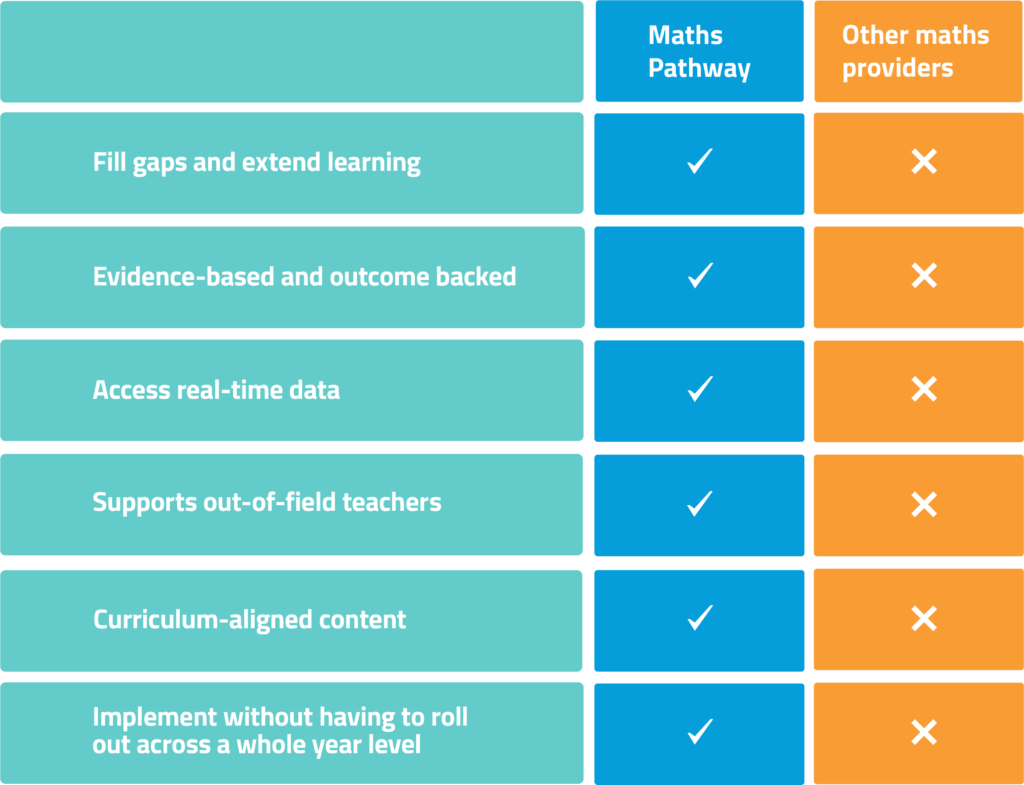A change in curriculum is the perfect time to reflect on your current approach to teaching and learning. It might feel like you already have enough to prepare for, but taking on a new approach could better support you and your class during this transition.
The right support can reduce the extensive workload created by endless administrative tasks, preparing curriculum-aligned content and organising lessons that cater to individual student needs.
When considering a new approach it’s important to ask yourself these three questions:
- Is your current strategy to strengthen student engagement and improve growth rates meeting your expectations?
- Is it difficult and time-consuming to find the data you need to inform practice and group students by individual needs?
- Are you feeling overwhelmed by the amount of work that is required to switch your classes to the new curriculum?
If answering those questions sparks concern, it might be time to start researching your options. We know this can be time-consuming, but it’s important to have all the information you need to make an informed decision.
There are many good quality resources available on the market today. With the ongoing development of EdTech, companies have been able to take their resources to the next level. However, this can’t be said for everyone, with many claiming to be personalised and curriculum-aligned without having the evidence and results to prove this.
So what should you look out for when considering a resource provider?
Do they fill gaps and extend learning with a personalised approach?
It’s empowering to feel seen as an individual with your own qualities, strengths, and areas of focus. This is certainly true for students who are encouraged along a personalised learning journey. Their motivation and excitement for learning stand out as their engagement improves and understanding grows. That’s why any resource should incorporate tools that support personalised learning so each student can focus on creating a stronger foundation and build on this in a way that meets their needs. A diagnostic tool, personalised lessons, one-on-one feedback, and goal setting are all tools that should be embedded in a personalised approach.
Are they evidence-based and outcome backed?
It’s important to read the evidence behind any product that you’re considering and look at the data generated by the students and teachers using the program. This will paint a clear picture early on of the effectiveness of a program and if it’s the right fit for your classroom.
You’ll often find that programs backed by sound research will take part in independent reviews of their practices to ensure they are keeping up with the changing needs of the school community.
Do they give you access to the data you need?
Research indicates that personalised learning enhances student growth, but to target teaching a clear outline of student abilities first needs to be established. The use of diagnostic tests and learning models that generate real-time data as students complete their work, is the most effective way to uncover insights. This data should also outline a clear view of the spread of ability and allow teachers to group students by their learning levels so small group intervention can take place.
How will they support out-of-field teachers?
Teaching out-of-field is a reality for many teachers, especially in STEM subjects where there is a widespread shortage of specialists. Teaching out of field is not only common for classroom teachers but also for substitute teachers who need to jump into the classroom on short notice.
Research shows that graduate teachers are more likely to be teaching out-of-field. 37% of Year 7-10 teachers with one to two years of experience are teaching out-of-field compared to 25% of teachers with more than five years of experience. With so many teachers placed in subjects they aren’t specialised in there needs to be a strong support network in place and an effective and timely classroom resource is no exception.
Do they have curriculum-aligned content?
Is there curriculum-aligned content created by maths teachers, curriculum specialists and former Heads of Maths? Any content development team should be creating new curriculum-aligned learning content, resources, and whole-class activities with fully worked solutions. This new content will be a great starting point for developing other resources your class needs.
How to approach a conversation with a potential resource provider
Download a free questionnaire below to take to your next meeting or send it through in an email to make sure any potential resource provider can actually support your classroom practice, improve growth rates and make the curriculum change a breeze.
